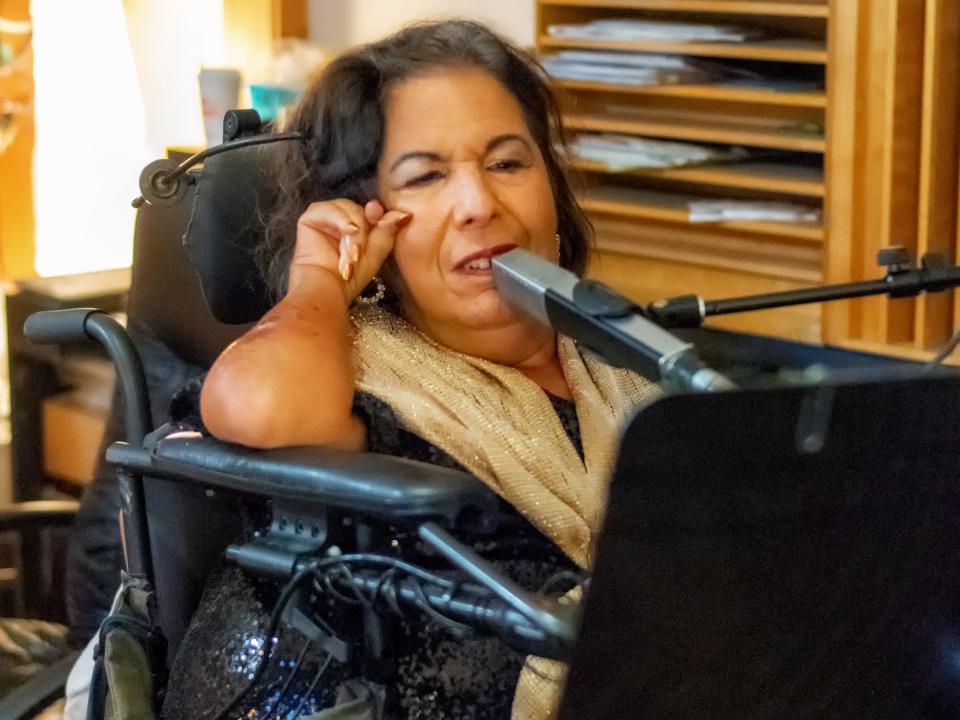At 63, I'm one of the oldest women living with my rare genetic condition. I'm also a musician, and thanks to new treatments, I'm going on tour.

Patricia Panzarino, or Pidgie, was born with spinal muscular atrophy type 2.
She's a musician, and recent advances in treatment gave Pidgie the ability to record an album.
This is Pidgie's story, as told to Kelly Burch.
This as-told-to essay is based on a conversation with Patricia Panzarino. It has been edited for length and clarity.
When I was born 63 years ago, doctors didn't know much about spinal muscular atrophy type 2, known as SMA2. My sister, who is 12 years older than me, had the same genetic condition, which often leaves people unable to stand or walk and increases the risk for eating and breathing problems. She was a mentor to me before I even knew what a mentor was.
I was fortunate enough to be born into a family that was all about making things work. I endured painful and ineffective treatments from doctors. There was no Americans With Disabilities Act, which meant there were no accommodations made for me at school. No one would help me go to the bathroom, so my mom came at lunch each day to assist me.
But at home, I thrived. My family enjoyed boating on the Long Island Sound, and my father rigged a lift so that I could drive. When I was 6, my mother enrolled me in piano lessons. That's when I discovered my real love: music.
Music was my constant companion until I lost my ability to play
I was a quick student with a good ear. Soon I ditched sheet music — it felt like painting by numbers. Improvising and writing songs allowed me the true creativity I craved.
Since those early days, music has been my heartbeat. It flows through my veins and makes up every cell. I constantly have a jukebox playing in my head. Music has been my constant companion through college, adulthood, marriage, and more.
About 10 years ago, my SMA symptoms became much worse. My muscles atrophied, and I was unable to play the piano anymore. My voice — my other instrument of choice — became so weak that I would get winded even from talking. Doctors said I would need to start using a ventilator during the day.
As this was happening, great strides were being made in treating SMA, but most new therapies were focused on children. Of course, I'm thrilled that children with this disease have treatment and the possibility of a cure. But the adults in the SMA community felt left out. Everyone deserves to have the same opportunities for health, well-being, and quality of life, but I feared it might be too late for me.
A new treatment allowed me to sing again
Luckily, I was wrong about that. Two years ago, I started a new at-home treatment for SMA called Evrysdi. Within a week, I felt better. I was able to talk and sing. Although I haven't regained my ability to play the piano, I was able to write and record an entire album. I called it "Just Breathe."
Bringing that album into the world felt like the score was Pidgie: 1, SMA: 0. There have been times in my life when I've run from my condition. There have been things I haven't been able to do — including having children.
Yet I'm living with SMA. I'm living life, not suffering from SMA, and not dying. It's true that I need more help than adults without disabilities. I rely on personal-care assistants to help me with dressing, driving, and other daily essentials. I'm only as active as my care assistants, which can be frustrating to a person who's as independent as I am.
I'm going on tour around New England and New York starting in May. I want people to see a woman with a disability living her best life. I'm big on inclusion — people with disabilities need to be visible. We're living longer, we're not going away, and we have a lot to offer. With my music, I want to empower and encourage people and bring them comfort and joy.
Read the original article on Insider

 Yahoo Sport
Yahoo Sport 





































